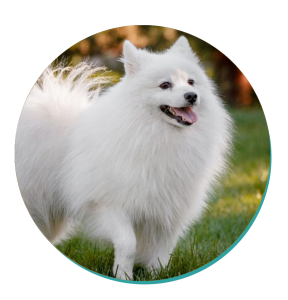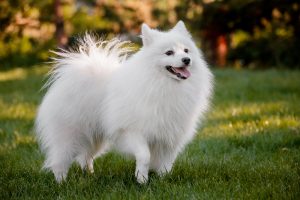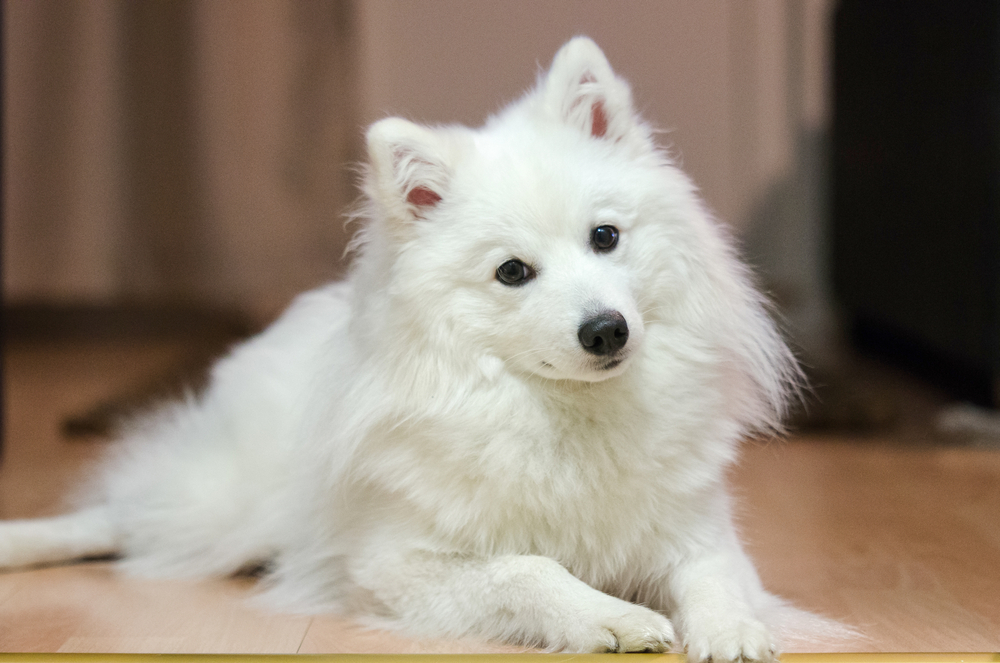
Quick Facts:
Height – 30-38cm
Weight – 5-10kg
Lifespan – 12-14 years
Country of origin – Japan
Best breed for:
- First time Dog Owners
- WFH Owners
- Apartment Living
Japanese Spitz History
Unlike many of the Japanese breeds, such as the Akita or the Shiba Inu, the Japanese Spitz is not an ancient, or even old, breed. In fact, they first appeared in the 1920s, when dog breeders asked themselves the common question, “How can we make the dogs we already love even cuter?” Their answer was to cross white German Spitz Dogs with American Eskimo Dogs and a sprinkling of other northern floofy pooches. What they got was the perfect companion animal: small enough to be right at home in an apartment, cute enough to be mistaken for a miniature polar bear, and friendly enough to be beloved by a wide range of potential Owners.
The Japanese Spitz was an instant success in their home country. But, like their fellow dog breeds over in Europe, WWII was not kind to this fluffy little pup. Luckily, the war didn’t end the breed completely, and lovers of the Japanese Spitz were able to build back a healthy breeding pool in the years after the war. Swedish dog lovers took an interest in the breed in the 1950s, a move that catapulted the doggo onto the world stage. Before long, major kennel clubs around the world had formally recognised the breed. The only hold out has been the American Kennel Club who isn’t convinced that the Japanese Spitz is different enough from their parent breeds, especially the American Eskimo Dog.
Despite the cold shoulder from the AKC, the Japanese Spitz has enjoyed pup-ularity all over the world as a companion animal and dog show star.
Japanese Spitz Personality
Given that the Japanese Spitz was bred specifically for companionship, it’s no surprise that this pooch has a winning personality. Let’s take a look at some of the character traits that add to this dog’s lovability!
For one thing, these puppers are friendly! They will get along with everyone from close family members to strangers to the neighbour’s cat. And, thanks to their socialite tendencies, Owners should be ready to expand their own social network every time they leave the house with this pooch.
That’s not to say that the Japanese Spitz isn’t capable of playing the role of guard dog. Sure, no one will be intimidated by the sight of this little poof of fur. But, their alertness will come in handy if the need ever arises to sound the alarm, and you’ll be surprised at how big of a bark can come from such a small dog.
Beyond the occasional need to protect the homestead, the Japanese Spitz shouldn’t be yappy or overly chatty. That said, because they were bred for companionship, they can develop separation anxiety if left alone for long periods of time. Without sufficient attention and exercise, they can certainly develop barking behaviours. It’s a great idea to find a loving local Pet Sitter who can keep your dog company while you’re away.
When you are at home with this little cloud of fluff, be prepared for an affectionate velcro dog. These pups love to be near or in the lap of their beloved Owners, regardless of whether you’re working, cleaning, or snoozing on the lounge. With proper exercise and mental stimulation, they’ll be relaxed and calm when you need them to be. And when the mood calls for it, they’ll snap back into their cheerful, playful selves.
One final thing to note about the Japanese Spitz personality is that these are small dogs, which can put them at risk for developing Small Dog Syndrome. This cluster of behaviours usually stems from fear and anxiety—the world can be a big, scary place for a small dog!—so special care should be taken to build confidence. Early socialisation with other dogs and exposure to a variety of different settings and situations is crucial for the wellbeing of a dog like the Japanese Spitz. These positive encounters will ensure that this sociable doggo can live up to their friendly, happy-go-lucky potential!

Trainability & Training Tips
When it comes to trainability, the Japanese Spitz has everything you want in a doggo! They’re people-pleasing, smart, and engaged, making them perfectly suited for Positive Reinforcement Training. Here are a few things to keep in mind when training this intelligent pooch:
- Build the bond. For a velcro dog like this one, the relationship between a Japanese Spitz and their trainer is invaluable. Making sure that your pup sees you as the giver of all treats, meals, and lovies is an important first step in building a training relationship, and it will make your dog so much more likely to listen to you when you’re ready to start teaching commands.
- Find an irresistible reward system. These pups tend to be motivated by many things, primarily food, play, and verbal praise from their beloved humans. You can rely on all of these to keep training sessions lively, fun, and most importantly, positive. Our tip: Stock up on a variety of treats and toys with different textures and flavours so that you can switch up the reward system when you need to win back your dog’s attention.
- Steer clear of harsh punishment. Most people-oriented dogs are sensitive to verbal punishment and other harsh corrections. And unlike some dogs who will double down on bad behaviour, the Japanese Spitz is likely to develop fear and aversion to training altogether. Protect the training bond by avoiding these types of training methods.
- Keep them well exercised. If your Japanese Spitz is bouncing off the walls and not listening to a word you say, you might have scoffed at us calling this dog highly trainable. To be sure, this is a dog that can be high strung and distractible! But, finding the right level of daily exercise is the perfect fix. In the next section, we’ll talk about how to manage this pup’s energy levels so that they’re always ready to be an ideal student.
- Stick to a schedule. All dogs benefit from consistency and predictability when it comes to house rules and routines. To help them learn faster, make sure to schedule daily training sessions—no more than ten to fifteen minutes at a time.
- Trust your doggo. The Japanese Spitz is one of the most pick-upable dogs we’ve ever seen. They’re so cute and fluffy that you want to carry them around wherever you go! But when it comes to training, it’s always best to keep four paws on the ground as much as possible. Let’s say, for instance, that your pooch is running around in the backyard even though you’ve been calling them to come inside. While it’s tempting to simply pick up your pup and carry them inside, they’re not really learning to come when called. Instead, they might just learn to be a bit sneakier the next time! What’s worse, in some scenarios, like meeting new dogs, picking up your pooch instead of training them how to interact pawsitively with others could put them on the path for Small Dog Syndrome. So, when it’s safe to do so, put that pupper on the ground! They’ll build confidence and have many more opportunities for training.
- Make room for puppy performances! You might fly through basic training with your Japanese Spitz and assume that you can leave the training there. But the truth is, training is such a wonderful bonding experience and opportunity for mental stimulation that we recommend it as a lifelong activity! These pups love the spotlight, so they make amazing dog dancers and trick performers. The sky is the limit for this barking cloud!
Exercise Needs & Living Conditions
They may not look it, but the Japanese Spitz comes from a long line of working doggos. After all, German Spitz dogs started out as herding and livestock guarding pups on farms. And, our pup in question hasn’t lost any of that athleticism or enthusiasm for exercise. In general, they need about an hour of exercise per day, although the exact amount of time will depend on the activity and personal endurance of each doggo. Here are a few ideas to tire out a Japanese Spitz:
- Walking. A nice brisk walk is an essential part of this dog’s exercise routine. They’re quick on their feet and enthusiastic about saying hello to everyone in the neighbourhood, so be ready to keep up with their fast-faced power walking! On the days that you can’t leash up your Japanese Spitz, be sure to call in the help of a dedicated Dog Walker. Outdoor adventures. If you’re a weekend warrior, let us introduce you to the weekend woofer. These little pups are so lively and fun-seeking that they’ll gladly hop on a paddle board, sit in a bicycle basket, or soak up some sun at the local dog beach.
- Swimming. This breed isn’t among the doggos who were bred specifically for swimming, but many are open-minded enough to give it a try! You can encourage your dog to take up swimming with doggy paddle lessons, and make sure to bring along their favourite floating toy to encourage them to hop in. A doggy life jacket is a good way to keep this little pup safe, even when they’re confident swimmers.
- Agility. We’ve miniaturised this pupper so much that it’s probably not possible for them to live out their past life as a farm dog. But, the weaving, jumping, and running involved in agility training is a great way to work the same muscles. Plus, agility training is a wonderful form of mental stimulation and opportunity for bonding with their favourite human!
- Free play with other dogs. A social dog like this one is bound to enjoy regular playdates with other dogs or trips to the dog park. Remember that socialisation is key for any dog, but especially those on the smaller side so that they learn to see all fellow floofers as friends!
When it comes to living conditions, it won’t surprise you to hear that this is an apartment-friendly dog. But, there are a few caveats! One, a Japanese Spitz needs sufficient mental stimulation and human interaction so that they don’t develop howling, chewing, and other habits related to separation anxiety. And two, they need enough exercise so as not to make their own (destructive) fun or try to make a great escape. As smart and athletic as they are, these dogs can wiggle out of open windows and hop over impressively tall fences.
As far as that fur coat goes, you needn’t worry about them melting in hot weather. They’ve got a double coat that does a pretty good job of filtering cool air to keep them cool. But, as with any dog, it’s always smart to be able to recognise the signs of heat exhaustion.
Japanese Spitz Grooming
Oh wow, look at that luxurious coat. It must require hours of grooming. In reality, the Japanese Spitz coat is a breeze to care for! With naturally self-cleaning qualities and a low doggy smell, you don’t need to set aside too much time or money for this dog’s grooming needs.
Brushing is really the only coat care task that Owners will need to do regularly. Invest in a few good grooming tools, such as an undercoat rake and a pin brush, and brush your pup from snout to tail a few times per week. You can also keep that coat shiny and soft by getting your pooch on a high quality raw diet packed with fresh proteins, natural fats and derma-strengthening veggies.
Beyond that, the Japanese Spitz requires regular tooth brushing, ear cleaning, and nail trimming. You may also need to wipe down their face daily to avoid staining around the eyes and mouth.
Japanese Spitz Health
In general, this breed is very healthy! Of course, every Pet Owner should take the proactive step of signing their fur baby up for a reliable pet insurance plan. But aside from unexpected injuries, this pooch has a short list of associated risks:
- Skin irritation. Overwashing a Japanese Spitz can lead to skin dryness and irritation, which is easily remedied with a more appropriate grooming plan
- Patellar luxation. These dogs can sometimes be prone to wear and tear of the kneecap.
Fun Fact
As a Japanese Spitz Owner, the most frequent question you’ll be asked is, “Is that a miniature Samoyed?” Actually, our fluffball in question is not as closely related to the Samoyed as other members of the Spitz group, even though they look very similar!
That said, another common statement you’ll hear is, “Goodness, I’ve never seen a white Pomeranian!” This one is actually more accurate, as the German Spitz and the Pomeranian both originated in Germany. There are, of course, some physical and personality differences between the two, but it’s up to you whether you want to offer a history lesson to those curious about your pooch!
Final Thoughts on the Japanese Spitz
It’s not very often that you come across a dog that is equal parts adorable, friendly, low maintenance, healthy, athletic and affectionate! But, the Japanese Spitz is no ordinary dog!
If you’re able to fulfill this pupper’s exercise, mental stimulation, and attention needs, you’ll have a dog who was designed to be the perfect companion. First time and experienced Dog Owners alike are sure to fall in love with the Japanese Spitz!


1 comment
I just lost my japanese spitz. I would like to own another one. Please. If you know of anyone who breeds japanese spitz pls email me. Thanks